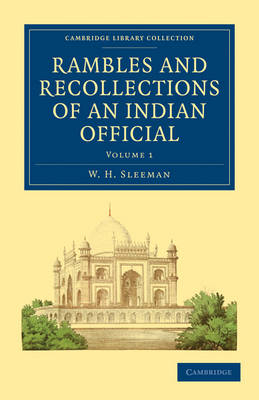
Rambles and Recollections of an Indian Official
Cambridge University Press (Verlag)
978-1-108-09230-2 (ISBN)
Lieutenant-Colonel William Henry Sleeman (1788–1856) spent his entire career in India as an army officer and later as a magistrate and resident. He was best known for his fight to suppress the activities of 'thugs', bands of criminals who attacked, robbed and often murdered innocent travellers. By the time of the publication of this two-volume work in 1844, Sleeman had lived in India for more than thirty years. In Volume 1, he draws on his travels and experiences, and over 48 chapters he discusses myriad aspects of Indian life, including Hinduism, local festivals and folklore, the 'thugs' he tried to eradicate, disease and famine, and the natural world. He also details the lives of a wide range of Indians, from key historical figures such as Aurungzebe, the Mogul emperor, to the ordinary people he encountered, such as washerwomen and elephant-drivers.
Dedication; 1. Annual fairs held upon the banks of sacred streams in India; 2. Hindoo system of religion; 3. Legend of the Nerbudda River; 4. A suttee on the Nerbudda; 5. Marriages of trees. The tank and the plaintain. Meteors. Rainbows; 6. Hindoo marriages; 7. The purveyance system; 8. Religious sects. Self-government of the castes. Chimney-sweepers. Washerwomen. Elephant-drivers; 9. The great Iconoclast. Troop routed by hornets. The Ranee of Gurba. Hornets' nest in India; 10. The peasantry and the land settlement; 11. Witchcraft; 12. The silver tree, or kulpa briksha. The Singhara, or trapa bispinosa, and the Guinea worm; 13. Thugs and poisoners; 14. Basaltic cappings of the sandstone hills of central India. Suspension bridge. Prospect of the Nerbudda valley. Deification of a mortal; 15. Legend of the Sauger Lake. Paralysis from eating the grain of the Lathyrus sativus; 16. Suttee tombs. Insalubrity of deserted fortresses; 17. Basaltic cappings. Interview with a native chief. A singular character; 18. Birds' nests. Sports of boyhood; 19. Feeding pilgrims. Marriage of a stone with a shrub; 20. The men-tigers; 21. Burning of Deoree by a freebooter. A Suttee; 22. Interview with the Rajah who marries the stone to the shrub. Orders of the Moon and the Fish; 23. The Rajah of Orcha. Murder of his many ministers; 24. Corn dealers. Scarcities. Famines in India; 25. Epidemic diseases. Scape-goat; 26. Artificial lakes in Bundelcund. Hindoo, Greek, and Roman faith; 27. Blights; 28. Pestle and mortar sugar-mills. Washing away of the soil; 29. Interview with the chiefs of Jansee. Disputed succession; 30. Haunted villages; 31. Interview with the Rajah of Duteea. Fiscal errors of statesmen. Thieves and robbers by profession; 32. Sporting at Duteea. Fidelity of followers to their chiefs in India. Law of primogeniture wanting among Mahomedans; 33. Bhoomeeawut; 34. The suicide. Relations between parents and children in India; 35. Gwalior plain once the bed of a lake. Tameness of peacocks; 36. Gwalior and its government; 37. Contest for empire between the sons of Shah Jehan; 38. Ourungzebe and Moorad defeat their father's army near Ojeun; 39. Dara marches in person against his brothers, and is defeated; 40. Dara retreats towards Lamore. Is robbed by the Jats. Their character; 41. Shah Jehan imprisoned by his two sons, Ourungzebe and Moorad; 42. Ourungzebe throws off the mask, imprisons his brother Moorad, and assumes the government of the empire; 43. Ourungzebe meets Shoojah in Bengal and defeats him, after pursuing Dara to the Hyphasis; 44. Ourungzebe imprisons his eldest son. Shoojah and all his family are destroyed; 45. Second defeat and death of Dara, and imprisonment of his two sons; 46. Death and character of Ameer Jumla; 47. Reflections on the preceding history; 48. The great diamond of Kohinoor.
| Erscheint lt. Verlag | 16.6.2011 |
|---|---|
| Reihe/Serie | Cambridge Library Collection - South Asian History ; Volume 1 |
| Zusatzinfo | 7 Plates, unspecified |
| Verlagsort | Cambridge |
| Sprache | englisch |
| Maße | 140 x 216 mm |
| Gewicht | 640 g |
| Themenwelt | Reisen ► Reiseberichte ► Asien |
| Geschichte ► Allgemeine Geschichte ► Neuzeit (bis 1918) | |
| Geisteswissenschaften ► Geschichte ► Regional- / Ländergeschichte | |
| ISBN-10 | 1-108-09230-6 / 1108092306 |
| ISBN-13 | 978-1-108-09230-2 / 9781108092302 |
| Zustand | Neuware |
| Haben Sie eine Frage zum Produkt? |
aus dem Bereich


